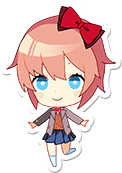



Zi Wang




Doki Doki Literature Club (hereinafter called Doki Doki) is a very special Galgame. I'm still blown away by how much Doki Doki Literature Club touched me. It contains some horror elements, but horror elements are not the only thing that strikes me. The game has created some very successful characters. These characters can even be considered like self-aware. Doki Doki has touched my humanity and made me think about the real and the virtual in a way that breaks the fourth wall.
Before playing Doki Doki, I noticed that it was a Galgame with horror tags. So, in my first game, I played very cautiously. But then the relaxed vibe made me let down my guard, so I paid more attention on its plot. Its plot is quite simple. The protagonist played by the player is invited by his childhood friend Sayori to join the literature club. The four members and the player then exchanged poems during the daily club activity time every day until the day of the accident.
According to the general idea of playing game, players need to do the following things to upgrade the favorability of the selected target and unlock more events. First, players need to select keywords related to the character they want to get in touch when creating poems every day. Second, players need to choose the favorite character as the first person to share every day. Third, support the favorite character in all options. But this game breaks the rules. After making all plausible options, players cannot get the expected ending. The first result I got was that Sayori committed suicide. That was very unexpected to me, and the creators did not give players direct prompts in the early stage.
But for Sayori's suicide, the creator did arrange some foreshadowing. Sayori will respond when the player clicks on keywords related to depression or suicide while writing poetry. It is the exact opposite of the positive and optimistic personality that Sayori showed in the beginning. Even though Sayori spoke out about the fact that she had been depressed for days, none of it made me think that she would actually commit suicide. And several other girls except Monica also ushered in the death of the ending. Players have to go through multiple heartbreaks and painful endings until Monica explains it all to the player.
In Doki Doki, the player's in-game behavior is difficult to be the guidance of the next game plus, because the ending of each round is as bad as it's set up. The happy ending requires players to keep saving and loading and operating background files. In the normal ending, deleting Monica's file causes garbled characters and errors. Although Monica keeps telling the player not to delete her, in order to achieve a happy ending, I still need to delete Monica's file. The difference between them is whether collected all the girls‘ CG or not. I think it also means whether I accompanied all the characters in the game. While it does not guide the later act, there are a few words that strike me. At the end of the first week, the protagonist thinks he will never have a chance to save Sayori. He kept repenting. It reminds me that life in the real world only happens once. We need to cherish the people around us and be grateful to them.
The most complete character in DokiDoki is Monica, followed by Sayori. Monica, as a character that cannot be chosen, falls in love with the protagonist (or the player). She generated her own consciousness. She is very possessive and wants to create a world with only Monica and the protagonist. In that scene, Monica has a lot of dialogue. Some are about everyday topics like weather, hobbies, food, etc. Some more in-depth topics on background files, depression, philosophy, etc. These conversations are like the trivial thoughts of a real person. It also completes the image of Monica as a self-aware anime character. Natsuki and Yuri have relatively thin personalities, but they both show distinct personal characteristics. Some characters have more description and others have less, which makes Monica more memorable to players as a special existence.
Doki Doki's background stage is a modern Japanese high school. Some anime or games are often modeled on Japanese high school life. Club activities and cultural festivals are also important events in this type of story that push the mainline. In Dokidoki, the whole plot is mainly based on club activities and the cultural festival. It sparked my interest in Japanese culture in a way, for example, I want to know what the life of a real Japanese high school student is like. Another theme in Doki Doki is the generation of self-awareness. Such themes are embodied in philosophical or sci-fi themes. When an individual who should not have self-consciousness suddenly has self-consciousness, should we eliminate it or respect it? This topic has no obvious answer now, and I won't delve into it here. In Doki Doki, we removed it for a happy ending. But the memory it leaves to the player is so real. The time I spend with them is so real. I think this also helped to have a new understanding of this game. What you spend time on, what becomes important to you. I also thank the creators for bringing them into the world and allowing some players to meet them in their lives.
I was hoping for a good ending after reaching a few bad endings. So I achieved the whole ending by saving, loading, and deleting files. The author has done a very good job of replayability. Because almost no player can reach a good ending the first time without a walkthrough. Players have to experience some spooky endings. And it prompted players to seek a better ending, for themselves and for the four girls in the game.
If it works as a linear narrative, I don't think Doki Doki will have the effect it currently has. If there is only a single linear narrative, the player may have no idea of the psychology of other characters. It was after the exploration in the new game plus that player developed more empathy for the four characters in the game. would want to liberate or redeem them.
Doki Doki's audiovisual elements are sometimes very impactful. At first, it created a calming atmosphere with a lovely visual style, upbeat music. Until I witnessed Sayori's death. That image really hit me because it was a completely different atmosphere from the previous ones. It also has spooky background music and zoom-in animation. The audiovisual element goes beyond the literal element in Doki Doki and is impressive. For example, near the happy ending, I saw the CG that Monica jumped out of the screen and hugged the player. Even though she doesn't exist in the real world, the mind of a player in the real world has left a memory that belongs to her. This picture also impressed me.
I think this form is the best form for Doki Doki. If I were to use the same structure as a story, it might also be a story of friendship and love. The protagonist can choose to help a character in the game but at the expense of another character. There is some misunderstanding among them, but the protagonist has to try to solve this misunderstanding. It will discover that unraveling this misunderstanding requires a third character that never existed. The third character wants to help, so she asks you to delete her file. In the end, only you remember that character, and everyone else doesn't remember her anymore.
There is not much interaction in Doki Doki. It has a relatively single game mechanism in the game. For example, choosing the words to write a poem or choosing the order of which girl to share the work with first. It doesn't involve resource management, only opinion value. In one game, players can only focus on one character. And more decisions are forced to advance the story, or the creators let Monica, who seems to have self-consciousness, force players to make some choices or experience some things. There is no real-time decision-making in Doki Doki. I think it can be changed to a real-time decision when players face the dilemma to favor a certain character. This change may increase the tension in the game.